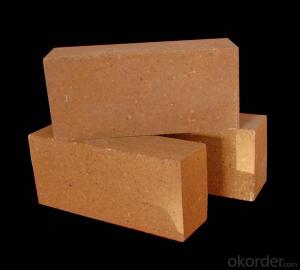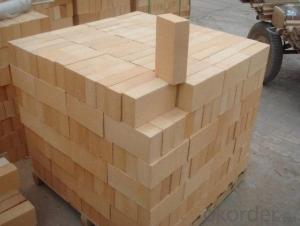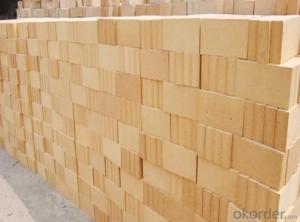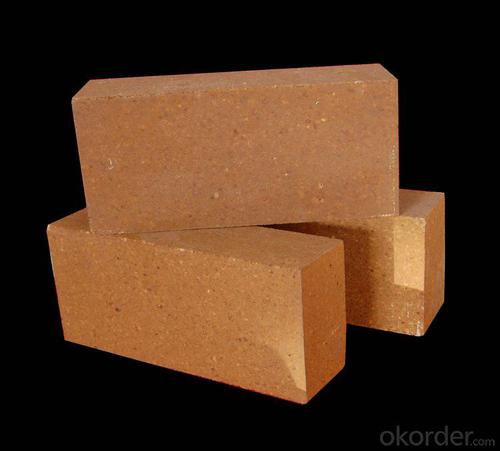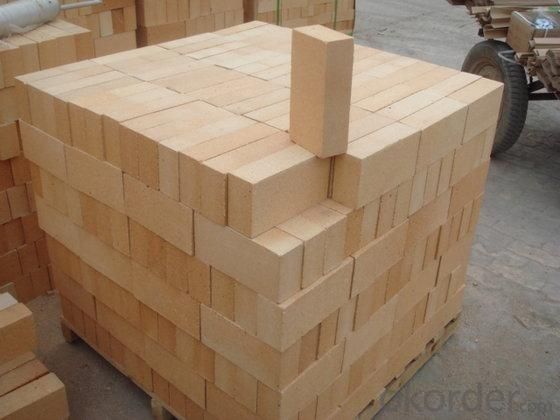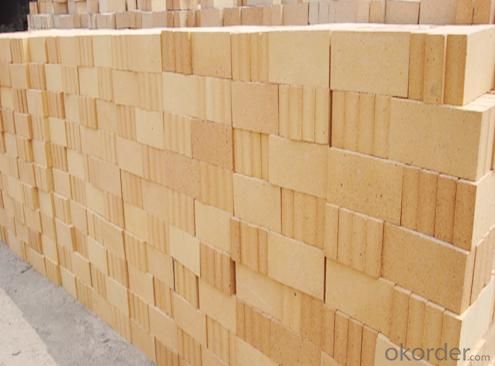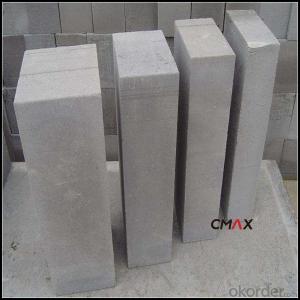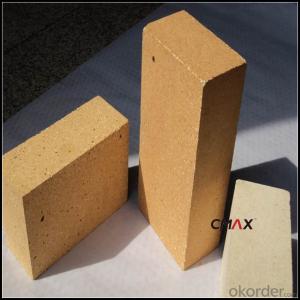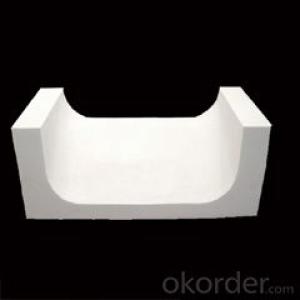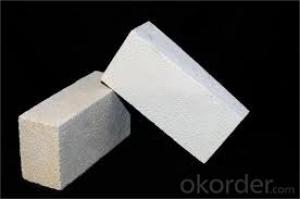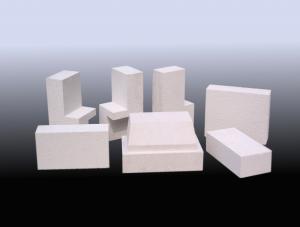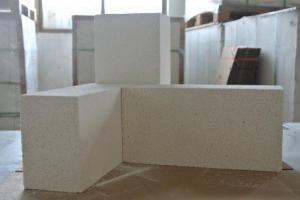Insulating Fire Brick - Quality Refractory Insulation Fire Brick
- Loading Port:
- China main port
- Payment Terms:
- TT OR LC
- Min Order Qty:
- 30 m.t.
- Supply Capability:
- 10000 m.t./month
OKorder Service Pledge
OKorder Financial Service
You Might Also Like
CNBM Alumina Fire Brick are classified according to alumina content ranging from 48% to 90%.
CNBM Alumina Fire Brick are commonly used in blast furnace, hot blast furnace, the roof of electric furnace, teeming ladle, rotary kiln, regenerator, etc.
Insulating Fire Brick Technical index
Product No. | IFB70 | IFB60 | IFB50 | IFB40 |
Al2O3 | 68%-72% | 58%-62% | 48%-52% | 38%-40% |
Refractoriness (°C ) | ≥1790 | ≥1790 | ≥1790 | ≥1790 |
Bulk density (g/cm3) | 2.50-2.60 | 2.35-2.45 | 2.20-2.30 | 2.10-2.20 |
Apparent porosity (%) | 22 | 19-22 | 17-20 | 17-20 |
Cold Crushing strength (kg) | 480-510 | 450-480 | 430-450 | 390-430 |
Application
Insulating Fire Brick are used for the lining of converter, alternating current arc furnace, direct Current arc furnace and the ladle slag line, etc.
Equipment
1 unit of Ceramic Abrasive (SG Abrasive) pilot production line
2 units of Compact grain Abrasive pilot production lines
1 unit of high-end coated abrasives (abrasive cloth) production line
Company Advantage
(1)Long Insulating Fire Brick manufacture history: 25 years manufacturer
(2)Advanced equipment
(3)Diversification of production standards: ISO ANSI FEPA JIS ASTM
(4)Flexible payment: T/T L/C D/P D/A
(5)Professional marketing team and after-sale service
(6)Free sample
FAQs
Q1 |
What’s the transport method? |
A1 | FCL delivery goods with wooden pallet or wooden case by sea; If LCL delivery, must with wooden case; Sometimes need open top, flat rack or bulk cargo. |
Q2 |
What’s the required payment term? |
A2 | Generally 30% TT as the prepayment, 70% TT before delivery. If need, 100% Irrevocable Letter of Credit or negotiation. |
Q3 |
Which country are our products exported to? |
A3 | Apart from entire Chinese market, the US, Russia, Japan, Korea, Australia and some Southeast Asian Nations. |
- Q: What is a JQK composite lightweight thermal insulation brick?
- It is a cement based composite waterproof mortar which is pressed and molded. The material has good heat preservation effect and high thermal conductivity.
- Q: Are insulating fire bricks resistant to phosphoric acid?
- Yes, insulating fire bricks are resistant to phosphoric acid.
- Q: Can insulating fire bricks be used in electric furnaces?
- Yes, insulating fire bricks can be used in electric furnaces. These bricks are specifically designed to withstand high temperatures and provide excellent insulation, making them suitable for use in electric furnaces where heat retention is crucial.
- Q: Can insulating fire bricks be used in the construction of pottery ovens?
- Yes, insulating fire bricks can be used in the construction of pottery ovens. These bricks are designed to withstand high temperatures and provide excellent insulation, making them an ideal choice for pottery ovens where heat retention is crucial for efficient and consistent firing of pottery.
- Q: Can insulating fire bricks be used to line industrial boilers?
- Industrial boilers can be lined with insulating fire bricks, which have low thermal conductivity and can minimize heat loss and enhance energy efficiency. These bricks, made of lightweight materials like clay and alumina, possess excellent insulation properties. By lining the boiler's interior with these bricks, the heat generated during combustion can be contained, resulting in greater heating efficiency and decreased fuel consumption. Moreover, these bricks are capable of withstanding high temperatures and thermal shocks, making them ideal for the challenging conditions commonly found in industrial boilers. Overall, utilizing insulating fire bricks as lining material can lead to improved energy efficiency, reduced operating expenses, and enhanced durability of the boiler system.
- Q: Can insulating fire bricks be used in the construction of foundry furnaces?
- Certainly, foundry furnaces can utilize insulating fire bricks in their construction. These bricks, composed of lightweight materials such as ceramic fibers, vermiculite, or perlite, possess excellent insulating properties. With their ability to withstand high temperatures, they are deemed appropriate for foundry furnaces. To endure the intense heat generated during metal melting, foundry furnaces necessitate materials that are heat-resistant. Insulating fire bricks, with their exceptional heat transfer resistance, effectively minimize heat loss within the furnace. Consequently, they are an ideal choice for insulating the furnace's walls and floor, thereby enhancing energy efficiency and reducing fuel consumption. Furthermore, the lightweight nature of insulating fire bricks facilitates their handling and installation during furnace construction. Their lightweight composition also reduces the overall weight of the furnace structure, making it more portable and easier to relocate, if necessary. In summary, due to their outstanding insulating properties, heat resistance, and lightweight characteristics, insulating fire bricks are a suitable option for constructing foundry furnaces. By improving efficiency and performance while enduring the extreme temperatures required for metal melting, they prove to be highly advantageous.
- Q: Can insulating fire bricks be used in the construction of gas kilns?
- Yes, insulating fire bricks can be used in the construction of gas kilns. Insulating fire bricks are designed to have low thermal conductivity, which means they can help retain heat and improve energy efficiency in a kiln. Gas kilns require proper insulation to ensure that heat is evenly distributed and maintained within the kiln chamber. Insulating fire bricks can be used to line the walls, floor, and ceiling of the kiln, creating a barrier that helps to prevent heat loss and improve the kiln's performance. Additionally, insulating fire bricks are lightweight and easy to work with, making them a popular choice for kiln construction projects.
- Q: Are insulating fire bricks easy to cut and shape?
- Yes, insulating fire bricks are relatively easy to cut and shape. They are made from lightweight refractory materials such as ceramic fibers, which make them easier to handle compared to traditional fire bricks. Insulating fire bricks can be cut and shaped using common tools such as a saw, knife, or chisel. Their lightweight nature also makes them easier to maneuver and position, allowing for more precise cuts and shapes. Additionally, insulating fire bricks can be easily drilled or carved to create openings or specific designs if needed. Overall, their ease of cutting and shaping makes insulating fire bricks a convenient choice for various applications in construction, insulation, and fireproofing.
- Q: Are insulating fire bricks resistant to alkali attack?
- Insulating fire bricks generally possess resistance to alkali attack. They are composed of high-temperature refractory materials and are engineered to endure extreme temperatures and chemical surroundings. Alkalis typically corrode and deteriorate certain substances, but insulating fire bricks are specifically devised to withstand this form of chemical assault. They possess limited porosity and a compact structure, thereby thwarting alkalis from infiltrating the brick's surface. Furthermore, the refractory materials employed in these bricks possess a high melting point and exhibit chemical inertness, rendering them ideal for situations where exposure to alkali is a concern. However, it is crucial to acknowledge that the resistance of insulating fire bricks to alkali attack may vary depending on the brick's composition, manufacturing process, as well as the concentration and duration of alkali exposure. Thus, it is always advisable to consult the manufacturer or supplier for comprehensive details regarding the alkali resistance of their specific insulating fire bricks.
- Q: Can insulating fire bricks be used in refractory cement?
- Yes, insulating fire bricks can be used in refractory cement. Insulating fire bricks are designed to provide thermal insulation in high-temperature applications, while refractory cement is used to create a strong and durable bond between bricks or other refractory materials. By using insulating fire bricks in conjunction with refractory cement, the overall thermal efficiency and insulation properties of the structure can be improved. This can help to reduce heat loss and increase the overall efficiency of the system. However, it is important to carefully follow the manufacturer's instructions and guidelines when using insulating fire bricks and refractory cement together to ensure proper installation and performance.
Send your message to us
Insulating Fire Brick - Quality Refractory Insulation Fire Brick
- Loading Port:
- China main port
- Payment Terms:
- TT OR LC
- Min Order Qty:
- 30 m.t.
- Supply Capability:
- 10000 m.t./month
OKorder Service Pledge
OKorder Financial Service
Similar products
Hot products
Hot Searches
Related keywords
